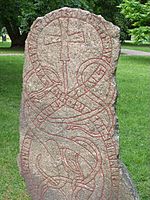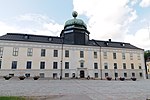Carolina Rediviva

Carolina Rediviva is the main building of the Uppsala University Library in Uppsala, Sweden. The building was begun in 1820 and completed in 1841. The original architect was Carl Fredrik Sundvall. Later additions to the building have been designed by Axel Johan Anderberg and Peter Celsing. The name, literally "Carolina Revived", was given in remembrance of the old Academia Carolina building, which had functioned as the university library for most of the 18th century (see Uppsala University Library). Carolina Rediviva is the oldest and largest university library building in the country. It is also the site where the Codex Argenteus and the Cancionero de Upsala are kept.
Excerpt from the Wikipedia article Carolina Rediviva (License: CC BY-SA 3.0, Authors, Images).Carolina Rediviva
Dag Hammarskjölds väg, Uppsala Fjärdingen
Geographical coordinates (GPS) Address Website External links Nearby Places Show on map
Geographical coordinates (GPS)
| Latitude | Longitude |
|---|---|
| N 59.854983333333 ° | E 17.631125 ° |
Address
Carolina Rediviva (Uppsala universitetsbibliotek)
Dag Hammarskjölds väg 1
753 10 Uppsala, Fjärdingen
Sweden
Open on Google Maps










